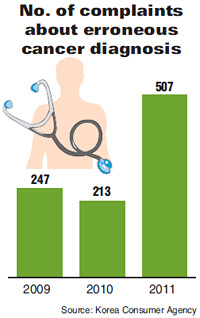Misdiagnoses on cancers rising sharply
Complaints double to 507
A 43-year-old woman, Lim, felt a lump in her left breast. Concerned, she had an ultrasound examination at a hospital in March 2010, but medical staff diagnosed the lump as benign.
Eight months later, when she sought a second opinion and got a checkup at another hospital, the lump was determined to be malignant. She lost precious time to treat the cancer at an early stage.
Lim belongs to a growing number of people who are victims of erroneous cancer diagnoses, according to the Korea Consumer Agency.
An agency report showed Wednesday that it had received 507 complaints on incorrect diagnoses in 2011, more than double the 213 filed in 2010. In 2009, it had 247 such complaints.
“Korea sees about 170,000 new cancer patients per year, and cancer stands a better chance to be cured if detected in the early stages. But these cases showed the diseases were not detected despite checkups and examinations because of medical errors, which aggravated the conditions,” an agency official, Kwon Nam-hee, said.
“In Lim’s case, the cancer was not confirmed through ultrasonography, so she was supposed to undergo additional tests, but doctors at the first hospital didn’t conduct them. They didn’t explain the need for follow-up checkups to her, consequently delaying detection of the disease,” she said.
On the sudden surge of wrong cancer diagnoses, Kwon presumed it was because of the increasing number of the elderly and more attention paid to health and medical checkups. The report showed those in their 40s to 60s accounted for 82.6 percent of the total victims of the wrong diagnoses.
About one third of these were a result of doctors’ negligence in conducting additional examinations. “In those cases, doctors noticed some minor abnormality when looking at an X-ray or ultrasound, but they didn’t regard it seriously; neither conducting additional tests nor telling this to the patients,” Kwon said.
In many other cases, doctors failed to detect lumps or other abnormal signs when examining ultrasound, radiographs or biopsy results.
About six out of 10 patients said the wrong diagnoses delayed their finding out about the diseases for about six months, while another 18.9 percent could detect the diseases between six and 12 months after the first wrong diagnosis. Such delay also worsened the patients’ condition, and 22.1 percent of the patients died as they missed the early chance of treatment.
“To prevent wrong diagnoses, people are advised to tell their medical history and symptoms in detail to doctors when receiving checkups. Even though the results come out as normal, they should consult doctors if they think there is something physically wrong,” she said.
“People should also ask doctors to fully explain the results, especially when if they use difficult medical terminology.” <The Korea Times/Kim Rahn>




















































